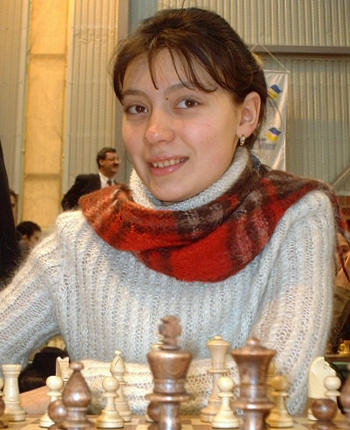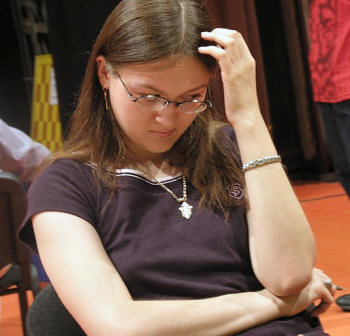| Latest | Greatest | Lobby | Journals | Search | Options | Help | Login |
|
|
|
This topic is archived. |
| Home » Discuss » Topic Forums » Sports |
|
| Jack Rabbit
|
Sun Dec-10-06 03:54 PM Original message |
| The Jack Rabbit Chess Report for December 10: In Memorium David Bronstein |
|
Edited on Sun Dec-10-06 04:09 PM by Jack Rabbit
The Jack Rabbit Chess Report for the week ending December 10  David Bronstein 1924 - 2006 Contents Post 1: News for the week Post 2: Diagrams and other features Post 3: Games from Current and Recent Events Post 4: Bonus Game: David Bronstein - Paul Keres, Goteborg, 1955 |
| Printer Friendly | Permalink | | Top |
| Jack Rabbit
|
Sun Dec-10-06 03:55 PM Response to Original message |
| 1. News for the week ending December 10 |
|
Edited on Sun Dec-10-06 04:39 PM by Jack Rabbit
Chess legend David Bronstein dies at 82
Grandmaster David Bronstein, who was once only a blunder away from being the world chess champion, died Tuesday in Minsk, Belarus, at the age of 82 after suffering a stroke. The height of Bronstein's career came in May 1951 when he tied a match for the world title in Moscow with then-world champion Mikhail Botvinnik at 12 points apiece. Botvinnik retained the title as the champion is given odds of a drawn match. Bronstein won the 21st and 22nd games of the 24-game event to take an 11½-10½ lead over Botvinnik and needed only to avoid loss in the last two games or to win one of the two games outright to become world champion. However, Bronstein blundered in a winning position in the 23rd game and lost; Botvinnik held Bronstein to a draw in the final game. For many years, the 23rd game had been the subject of much speculation with rumors flying that Soviet authorities forced Bronstein to throw the game to Botvinnik, a favorite of the Communist establishment. Bronstein himself seemed at times to feed those rumors, but at other times said the loss was his own decision as he did not wish to his his personal life and private views become the subject of public and government scrutiny as they would have had he won the match. Bronstein won the right to play Botvinnik by tying for first place in the Candidates' Tournament held in Budapest the previous year with his older contemporary and good friend, Isaak Boleslavsky. Bronstein then defeated Boleslavsky in a playoff match held later in 1950 in Moscow. Bronstein won many major tournaments and was twice Soviet Champion, in 1948 and 1949. He also represented the Soviet Union in four chess olympiads.  The 1954 Soviet Olympic Team in Amsterdam Rear: Vasily Smyslov, Paul Keres Front: David Bronstein, Mikhail Botvinnik David Ionovich Bronstein was born near Kiev on February 19, 1924. When Bronstein was in his teens, his father, Ion Bronstein, who had been an active Bolshevik before Bronstein's birth, was sent to the Siberian salt mines on trumped up charges. The elder Bronstein was released in poor health after eight years and, two years after his death, exonerated by Soviet authorities during the de-Stalinization period. David Bronstein never forgave the Soviet government for his father's false imprisonment and pointedly refused to join the Communist Party, even though it would have been advantageous for him to do so. The fate of the elder Bronstein also led to a story that Bronstein was related to Leon Trotsky, who's own father's name was David Bronstein. In his autobiographical book, The Sorcerer's Apprentice, Bronstein states that the stories are not true. In spite of the imprisonment of his father, Bronstein, who was proud of his Ukrainian Jewish heritage, wished to serve in the fight against Hitler. His severe nearsightedness prevented him from being taken into the Red Army, but he was sent to Stalingrad to help rebuild a factory. In 1948, during a torunament in Saltsjobaden, Austria, Bronstein was attacked by a spectator while playing a game. The assailant was a Soviet expatriot who said he wanted to "kill Russians". Given Bronstein's bitterness toward the Soviet regime and the Ukrainian Jew, not a Russian, makes one wonder why the man chose Bronstein as a target. Bronstein shrugged off the incident and proceeded to win the game. In 1976, Bronstein was one of a very few Soviet grandmasters who refused to sign a letter denouncing his friend, Viktor Korchnoi, after Korchnoi defected to the West. Bronstein was not permitted to play chess abroad for 14 years and even had his activity within the Soviet Union limited. Bronstein championed an individualistic and intuitive approach to chess which emphasized creativity and imagination. This was at odds with official Soviet doctrine, which placed emphasis on a collective, institutionalized approach championed by Bronstein's rival in 1951, Botvinnik. Bronstein often liked to call himself a chess artist, which is to say he sought out possibilities of beauty in striking combinations. His personal style aggressive. In a age of positional chess, Bronstein did not fear on occasion to play the King's Gambit as White, even in an important game. Bronstein loved a beautiful chess game, even those he lost. He own game collections, such as The Sorcerer's Apprentice and 200 Open Games, include defeats that are as breathtaking as some of his victories. He was very well liked by his peers. Bronstein was admired for his story telling and his enthusiasm for position rich in possibilities. He would discuss chess with anyone who shared his passion for the game, whether a grandmaster or a club player. He is credited with many opening innovations and, along with Boleslavsky and the Argentine graster Najdorf, did much to enhance the reputation of the King's Indian Defense in the years after World War II. Bronstein is survived by his widow, Tatiana Boleslavskaya, a Minsk university professor 22 years his junior whom he married in 1983. She was his third wife and is the daughter of his old friend and rival, Isaak Boleslavsky. Efimenko, Vozovic reign as Ukrainian Champions  Zahar Efimenko and Oksana Vozovic are the new Ukrainian chess champions. Efimenko won the general competition, a single-elimination event that began in Poltava November 24 with 32 players, including 16-year-old Katya Lahno, Ukraine's leading woman player, Pavel Eljanov and Alexander Areshchenko. Efimenko and Yuri Drozdovskij were the last two standing when the fifth and last round began on December 2. The first game was drawn, but Efimenko scored a win with the Black pieces the following day to take the title. Unofficial Cross Table Ukrainian National Ladies Championship Odessa -------------------------- 1 2 3 4 5 6 7 8 9 0 1 2 T- (W) (-SB) .1 Oksana Vozovic . . . . .- ½ ½ ½ 1 ½ 1 1 ½ 1 1 ½ 8. (5) (41.) .2 Anna Ushenina, . . . . .½ - ½ ½ ½ 1 1 ½ 1 1 ½ 1 8. (5) (39¼) .3 Natalia Zdebskaya. . . .½ ½ - 1 ½ 0 1 1 ½ 1 1 ½ 7½ (5) . . . .4 Natalia Zhukova. . . . .0 ½ 0 - ½ ½ ½ 1 1 1 1 1 7. (5) (30¾) .5 Inna Goponenko . . . . .½ ½ ½ ½ - 1 0 ½ 1 ½ 1 1 7. (4) (34¼) .6 Maria Muzychuk . . . . .½ 0 1 ½ 0 - 1 0 ½ ½ ½ 1 5½ (3) . . . .7 Olga Kaninina. . . . . .0 0 0 ½ 1 0 - 0 1 ½ 1 1 5. (4) (21½) .8 Tatiana Vasilevich . . .0 ½ 0 0 ½ 1 1 - ½ ½ 0 1 5. (3) (24.) .9 Katerina Dolzhikova. . .0 0 ½ 0 0 ½ 0 ½ - 1 1 ½ 4. (2) (17.) 10 Daina Arutyunova . . . .½ 0 0 0 ½ ½ ½ ½ 0 - 1 ½ 4. (1) (19¼) 11 Galina Breslavska. . . .0 ½ 0 0 0 ½ 0 1 0 0 - 1 3. (2) . . . 12 Svetlana Ivanova . . . .½ 0 ½ 0 0 0 0 0 ½ ½ 0 - 2. (0) . . . The Jack Rabbit Unofficial Cross Table uses games won as first tie break Ms. Vozovic won ladies' event, a single round robin among 12 twelve players held in Odessa from November 26 through December 6. Anna Ushenina lead the event most of the way, but Ms. Vozovic caught up with Ms. Ushenina in round ten, tying for first with 7 points each. Both player won their games the following day and Ms. Vozovic was declared the ladies' national champion by virtue of a superior Sonnenborn-Berger score, the tiebreak used in most chess tournaments. Russian Superfinals underway   The final leg of the Russian National Championships, called the Superfinals, is underway in Moscow and Gorodents. The general division of the Superfinal began last Sunday in Moscow. The event is now in the seventh round with a four-way tie for first place among Dmitry Jakovneko, Evgeny Alekseev, Idlar Khairullin and the tournament's top seed, Peter Svidler. Jakovenko had opened up a one-point lead yeasterday, but lost today to Khairullin while Svidler defeated 16-year-old Ian Nepomniachtchi (get used to that name, it's yahn nay powm NYACH chee) while Alekseev scored a Black win against Denis Khismatullin. Unofficial Cross Table Russian National Championship General Superfinal Moscow -------------------------- 1 2 3 4 5 6 7 8 9 0 1 2 T- (W) .1 Dmitry Jakovenko . . . .- ½ 0 ½ . 1 . 1 ½ 1 . . 4½ (3) .2 Evgeny Alekseev. . . . .½ - ½ ½ . . 0 . 1 . 1 1 4½ (3) .3 Ildar Khairullin . . . .1 ½ - . ½ . ½ 1 . . ½ ½ 4½ (2) .4 Peter Svidler. . . . . .½ ½ . - ½ ½ . 1 1 ½ . . 4½ (2) .5 Sergey Grigoriants . . .½ . ½ ½ - . ½ ½ ½ . 1 . 4. (1) .6 Ernesto Inarkiev . . . .0 . . ½ ½ - ½ . 1 * . 1 3½ (2) .7 Sergei Rublevsky . . . .. 1 ½ . ½ ½ - 0 . ½ ½ . 3½ (1) .8 Ian Nepomniachtchi . . .0 . 0 0 ½ . 1 - . . 1 ½ 3. (2) .9 Denis Khismatullin . . .½ 0 . 0 . 0 . . - ½ . 1 2½ (1) 10 Evgeny Tomashevsky . . .0 ½ . ½ . * . . ½ - ½ ½ 2½ (0) 11 Evgeny Najer . . . . . .. 0 ½ . 0 . ½ 0 . ½ - ½ 2. (0) 12 Nikita Vitiugov. . . . .. 0 ½ . . 0 . ½ 0 ½ ½ - 2. (0) The Jack Rabbit Unofficial Cross Table uses games won as first tie break One game in the seventh round is incomplete, that between Ernesto Inarkiev and Evgeny Tomashevsky. As of yesterday, Inarkiev was one of several players tied for second a point behind Jakovenko. However, today's game appears to be drawn. After 63 moves, White (Inarkiev) is threatening mate in one; however, White's King is in check and has only one legal move. Black should be able claim a draw by pertetual check and he has nothing better. The general Superfinal will finish after the eleventh round on Friday. Tuesday will be a rest day. The ladies' Superfinal began Friday, December 1, in Gorodents, a 12th century city linked with the legendary warrior-prince, Alexander Nevsky. After nine rounds, 21-year-old Ekaterina Korbut leads with seven points, a half point ahead of the Kosintseva sisters, Nadezhsa and Tatiana, who are tied for second. Ms. Korbut leads by virtue having defaeated both of the sisters, Nadezhda in round one and Tatiana in yesterday's eighth round. Up until then, it looked like a two-way race between Tatiana and 15-year-old Elena Tairova, but Ms. Tairova also tasted defeat yesterday at the hands of Alisa Gilliamova, the runner up in this year's women's world championship event. Unofficial Cross Table Russian National Championship Ladies' Superfinal Gorodets -------------------------- 1 2 3 4 5 6 7 8 9 0 1 2 T- (W) .1 Ekaterina Korbut . . . .- 1 1 1 . ½ ½ 0 1 1 1 . 7. (6) .2 Tatiana Kosintseva . . .0 - ½ 1 ½ ½ 1 1 . 1 1 . 6½ (5) .3 Nadezhda Kosintseva. . .0 ½ - . ½ . 1 1 1 ½ 1 1 6½ (5) .4 Alisa Galliamova . . . .0 0 . - ½ 1 ½ 1 1 . 1 1 6. (5) .5 Elena Tairova. . . . . .. ½ ½ ½ - . 0 1 1 1 ½ 1 6. (4) .7 Ekaterina Kovalevskaya .½ ½ . 0 . - ½ 1 ½ ½ 1 1 5½ (3) .6 Tatiana Shadrina . . . .½ 0 . ½ 1 ½ - . 1 . 1 ½ 5. (3) .8 Elena Zayats . . . . . .1 0 0 0 0 . 0 - 0 1 . 1 3. (3) .9 Anatasia Bodnaruk. . . .0 . 0 0 0 ½ 0 1 - 0 . 1 2½ (2) 10 Svetlana Matveeva. . . .0 ½ . 0 0 ½ . 0 1 - ½ 0 2½ (1) 11 Maria Koniagina. . . . .0 0 0 . ½ 0 0 . . ½ - 1 2. (1) 12 Valentina Gunina . . . .. 0 . 0 0 0 ½ 0 0 1 0 - 1½ (1) The Jack Rabbit Unofficial Cross Table uses games won as first tie break At 15, Ms. Tairova isn't even the youngest player in the tournament. That honor goes to 14-year-old Anastasia Bodnaruk, The ladies' tournament will wrap up with the eleventh round Tuesday. Kazhgaleyev, Koneru win first Olympic gold medals in chess  Murtas Kazhgaleyev of Kazakhstan and India's Koneru Humpy are the first recipients of gold medals for chess from an official Olympic competition in the Asian Games in Doha, Qatar. Kazhgaleyev won the men's and Ms. Koneru the women's individual rapid chess competition. Kazhgaleyev scored 7½ points out of 9 games to take the gold. Kazhgaleyev won 6 games and drew 3. Bu Xiangzhi of China and Dao Thien Hai of Vietnam tied for second with 7 points apiece. Each won 6 games with 2 draws and a loss. Kazhgaleyev and Bu were tied for first going to the final round, where Kazhgaleyev defeated Sasikiran Krishnan of India while Bu was held to a draw against Uzbekistan's Rustam Kazimdzhanov. Ms. Koneru, 19, currently the second ranked woman player in the world behind Judit Polgar, won 8 and lost one in winning the gold. The silver medal went to Zhao Xue of China who scored 7½ points (7 wins, one draw and a loss) while the bronze was won by China native Zhu Chen of Qatar with 6 points. Currently underway in Doha is the mixed teams Swiss system event. Each team consists of two men and one woman. After four rounds, India leads the competition with 10 points out of a possible 12, with China second with 9 points. Qatar, featuring the husband-and-wife team of Mohammed al-Modiahki and Zhu Chen, is third with 8½ points. |
| Printer Friendly | Permalink | | Top |
| Jack Rabbit
|
Sun Dec-10-06 03:57 PM Response to Original message |
| 2. Diagrams and other features of the JR Chess Report |
|
!""""""""# $tMvWlVmT% $OoOoOoOo% $ + + + +% $+ + + + % $ + + + +% $+ + + + % $pPpPpPpP% $RnBqKbNr% /(((((((() White to move This position is a theoretical draw Does this picture make sense to you? If not, or if it looks like a bunch of Wingdings, please click here. Diagrams used in the Jack Rabbit Chess Report are made with Chess Merida, a true type font that is available as freeware at the above link. Also, the JR chess report makes the main variation in annotations more distinct and readable by putting it in red. A secondary variation, is in blue and other colors are used if needed. |
| Printer Friendly | Permalink | | Top |
| Jack Rabbit
|
Sun Dec-10-06 03:58 PM Response to Original message |
| 3. Games from current and recent events |
|
Edited on Sun Dec-10-06 04:10 PM by Jack Rabbit
Chess Games Analysis by JR and Fritz Oksana Vozovic - Katerina Dolzhikova, Ukrainian Ladies' National Championship, Round 10, Odessa Maria Muzychuk - Anna Ushenina, Ukrainian Ladies' National Championship, Round 7, Odessa Ian Nepomniachtchi - Sergey Rublevsky, Russian National Championships, General Superfinal, Moscow, Round 4 Elena Zayatz - Tatiana Kosintseva, Russian National Championships, Ladies' Superfinal, Gorodets, Round 4 |
| Printer Friendly | Permalink | | Top |
| Jack Rabbit
|
Sun Dec-10-06 04:01 PM Response to Reply #3 |
| 5. Vozovic - Dolzhikova, Ukrainian National Championships, Odessa |
 Oksana Vozovic To view this game: Please click here and select the next-to-last game. Oksana Vozovic vs. Katerina Dolzhikova Ukrainian National Championships, Round 10 Odessa, December 2006 Moorish Game: Horseman Defense (Alekhine Defense) 1. e4 Nf6 2. Nc3
Black: Katerina Dolzhikova !""""""""# $tW T +l+% $Ov+mVoO % $ + +o+ O% $+ +mN + % $ + P P +% $+ +b+ +n% $pP Bq+pP% $R + +rK % /(((((((() White: Oksana Vozovoc Position after 18. -- Nf6d7 19. Qh5!
|
| Printer Friendly | Permalink | | Top |
| Jack Rabbit
|
Sun Dec-10-06 04:02 PM Response to Reply #3 |
| 6. Muzychuk - Ushenina, Ukrainian National Championships, Odessa |
 Anna Ushenina To view this game: Please click here and select the game Mazychuk-Ushenina. Maria Muzychuk vs. Anna Ushenina Ukrainian Championships, Round 7 Odessa, December 2006 Spanish Sicilian Game: Rossolimo Opening (Lutikov Gambit) 1. e4 c5 2. Nf3 Nc6 3. Bb5 g6 4. 0-0 Bg7 5. c3 Nf6 6. d4?!
Black: Anna Ushenina !""""""""# $ +t+t+l+% $Ov+oBoVo% $ W + +o+% $+ +p+ + % $ +o+ Q +% $+ + +n+ % $p+ + PpP% $+r+ R K % /(((((((() White: Maria Muzychuk Position after 23. -- Qa6! |
| Printer Friendly | Permalink | | Top |
| Jack Rabbit
|
Sun Dec-10-06 04:03 PM Response to Reply #3 |
| 7. Nepomniachtchi - Rublevsky, Russian Superfinals, Moscow |
 Ian Nepomniachtchi Ian Nepomniachtchi vs. Sergei Rublevsky Russian Championships, Round 4 Moscow, December 2006 Open Sicilian Game: Kan Defense 1. e4 c5 2. Nf3 e6 3. d4 cxd4 4. Nxd4 a6 5. Nc3
Black: Sergei Rublevsky !""""""""# $ + +t+l+% $+o+ WoOo% $ +m+ M +% $T No+ B % $o+ + + +% $+ Pb+ Qp% $p+p+ Pp+% $+k+rR + % /(((((((() White: Ian Nepomniachtchi Position after 20. -- Ra8a5 21. Nd7!!
|
| Printer Friendly | Permalink | | Top |
| Jack Rabbit
|
Sun Dec-10-06 04:05 PM Response to Reply #3 |
| 8. Zayatz - T. Kosintseva, Russian Superfinals, Gorodents |
 Tatiana Kosintseva To view this game with a PGN viewer:
Elena Zayatz vs. Tatiana Kosintseva Russian National Championships (Ladies' Superfinal), Round 4 Gorodets, December 2006 King's English Game: Four Knights' Opening 1. c4 Nf6 2. Nc3 e5 3. Nf3 Nc6 4. d4
Black: Tatiana Kosintseva !""""""""# $t+vWl+ T% $OoOo+oOo% $ + + M +% $+ +p+ + % $ Vp+n+ +% $+ N + + % $pPq+pPpP% $R B Kb+r% /(((((((() White: Elena Zayantz Position after 8. Ng5xe4 8. -- Nxd5!
Black: Tatiana Kosintseva !""""""""# $t+ + L T% $Oo+ WoOo% $ M + V +% $+ + + + % $ +vOp+ +% $P + + P % $ B QnP P% $+ Kr+b+r% /(((((((() White: Elena Zayantz Position after 24. Qd3d2 24. -- Rc8!
|
| Printer Friendly | Permalink | | Top |
| Jack Rabbit
|
Sun Dec-10-06 04:00 PM Response to Original message |
| 4. Bonus Game: Bronstein - Keres, Goteborg, 1955 |
 David Bronstein Reference: David Bronstein and Tom Fürstenberg, The Sorcerer's Apprentice (London: Everyman Chess, 1995), p. 50. David Bronstein vs. Paul Keres Interzonal Tournament, Round 7 Goteborg, August 1955 East India Game: Nimzo-Indian Defense 1. d4 Nf6 2. c4 e6 3. Nc3 Bb4 4. e3 c5 5. Bd3 b6 6. Nge2
Black: Paul Keres !""""""""# $t+ W Tl+% $Ov+oVoO % $mO + M O% $+n+ + + % $ +o+ + +% $P + + N % $ Pb+ PpP% $R Bq+rK % /(((((((() White: David Bronstein Position after 13. -- d5xc4 14. Bxh6!?
|
| Printer Friendly | Permalink | | Top |
| Lithos
|
Mon Dec-11-06 12:08 AM Response to Reply #4 |
| 9. A classic game |
|
Edited on Mon Dec-11-06 12:09 AM by Lithos
Sacrifices such as these are equal parts bravado, psychology and strategy. It breaks the line of thought of your opponent, which given their personality may result in a mistake that allows such a strong follow up as Qd2 was here.
I would have loved to have been in the room during those few moves. There is a whole story in those few moves. L- |
| Printer Friendly | Permalink | | Top |
| Jack Rabbit
|
Tue Dec-12-06 02:49 PM Response to Reply #9 |
| 10. There are so many games by Bronstein that would have been suitable |
|
Like this one, often beautiful and brilliant with a dash of recklessness.
Although Bronstein helped systems developers with chess programs, he was of the humanist school, like Lasker and Tal. Perhaps there is something to the coincidence that he died on the day that Kramnik went down to Deep Fritz. |
| Printer Friendly | Permalink | | Top |
| DU
AdBot (1000+ posts) |
Thu Apr 18th 2024, 11:00 PM Response to Original message |
| Advertisements [?] |
| Top |
| Home » Discuss » Topic Forums » Sports |
|
Powered by DCForum+ Version 1.1 Copyright 1997-2002 DCScripts.com
Software has been extensively modified by the DU administrators
Important Notices: By participating on this discussion board, visitors agree to abide by the rules outlined on our Rules page. Messages posted on the Democratic Underground Discussion Forums are the opinions of the individuals who post them, and do not necessarily represent the opinions of Democratic Underground, LLC.
Home | Discussion Forums | Journals | Store | Donate
About DU | Contact Us | Privacy Policy
Got a message for Democratic Underground? Click here to send us a message.
© 2001 - 2011 Democratic Underground, LLC